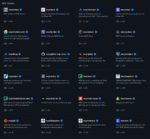The last week of May and the first week of June are incredibly busy times for developers. Between AnDevCon, DockerCon, Hadoop Summit, WWDC, Tizen Conference, Google I/O and newcomer Solid, it’s a wonder we aren’t completely buried in conference materials, enthusiastic evangelists, and developers racing around their long-sticking bugs thanks to conference knowledge.
In truth, I’ve noticed something these past weeks as I’ve pushed my way through many of these conferences (or prepared to do so for others). There is a general bitterness and cynicism among mobile developers that is not present on other platforms.
Take AnDevCon, WWDC and Tizen Conference, versus Hadoop Summit and DockerCon. Even though DockerCon hasn’t even taken place yet, this week, at Hadoop Summit, Arun Murthy (father of YARN) announced that the future of Hadoop management, deployment and packaging will be based on Docker. That’s an immense combination, indicative of the momentum, rapid pace of innovation, and excitement in Big Data and the world of Linux Containers.
Meanwhile, all three mobile development conferences were basically filled with developers who have been struggling for years to find success in an increasingly crowded and shovelware-filled marketplace. The perils of discovery mean that mobile development is a near zero-sum game for the independent developer.
When a dozen clones of Flappy Bird and 2048 each rake in half a million dollars a year for their lazy yet opportunistic developers, why would you ever bother making something unique? There are still many wonderful passion-driven products in mobile app stores, but the vast majority of applications are completely ignored.
This is why there is a giant industry for paid installs. If you’re in the top 100 app store apps, you can make a living on your app sales. If you’re in the top 25, you can get rich. But if you’re not in either one of these categories, you’re basically selling ice to Eskimos, even if your ice can balance your checkbook, start your car and make you dinner.
And thus mobile developers are desperate for any type of technology that can give them an edge. Developing for smartwatches, health-monitoring devices, Chromecasts, Google Glass, automotive integrations—anything to stand out from the crowd.
Alternately, developers are flocking to smaller app stores, like Windows Phone, BlackBerry and Tizen. Moving to these smaller ponds, the thinking goes, means more chances to make money, right? Unfortunately, these strategies amount to optimizing the heck out of 5% of your business rather than working on fixing what’s wrong with the 95%.
And what’s wrong with your app that you can’t get discovered anyway? I’m sure app-store failure has resulted in a great deal of soul searching from newly indoctrinated mobile developers, those that have quit their day job to focus on solo development of a niche product.
Don’t get me wrong, it is possible to succeed in the app stores. There are new examples every day of innovative apps that fill a need and carve out a market space that can replicate a US$50,000 to $100,000 job. But the sad fact is that the success rates of mobile developers are significantly lower than those of more discoverable platforms.
Take Steam, for example. There, even the least popular, most obscure games average around 10,000 lifetime purchases as their baseline. And Steam prices can go significantly higher than the $1-$5 price point of mobile software.
The answer is discovery. Steam is a constantly changing content delivery platform, shifting its windows into the applications it sells almost daily. From the scrolling new releases to the social aspects of finding games your friends have purchased, Steam is a model for how an app store should work.
Unfortunately, I’m convinced that Apple and Google have little interest in fixing this problem. They make the same amount of money either way, and at the end of the day, the app-store profits these companies make are so infinitesimal next to their more mainstream profit lines (hardware for apple, search ads for Google) that there’s no reason for them to optimize.
In fact, as Google and Apple increasingly control the ad streams of their app-store apps, it behooves them to promote crappy software: less attention drawn away from the ads and more free apps mean more ad-driven development models.
It’s a sad state of affairs. It rivals the 1984 video-game market collapse, or the 1996 CD-media flush out. Both times, new distribution models and software markets were absolutely flooded with shoddy software sold to people who didn’t know what they were buying. From the E.T. Atari game to the stacks of Health Almanac and Encyclopedia CDs under everyone’s desks, we’ve been in this software market glut before. The results are never pretty.
In 1984, millions of Atari games were buried in the desert. In 1996, the videogame software market pivoted to become the home software market, and in doing so left behind Sega, 3DO, Apple and Phillips with completely DOA product lines. But today it costs almost nothing to put something into app stores. How can a market flush out if there’s no unsold stock eating rent in a warehouse, and no shelf space to fight for with the distributors and retailers?
Are we doomed to forever exist in this app store hell?





